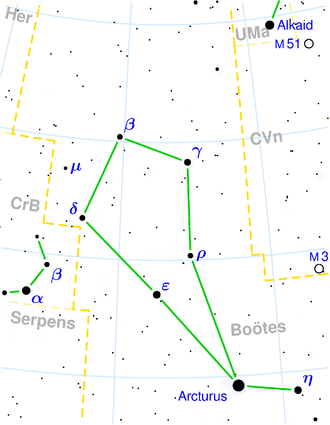NGC 5579
| Galaxy NGC 5579 |
|
|---|---|

|
|
| SDSS recording | |
| AladinLite | |
| Constellation | Bear keeper |
|
Position equinox : J2000.0 , epoch : J2000.0 |
|
| Right ascension | 14 h 20 m 26.5 s |
| declination | + 35 ° 11 ′ 20 ″ |
| Appearance | |
| Morphological type | SABcd |
| Brightness (visual) | 13.7 mag |
| Brightness (B-band) | 14.4 mag |
| Angular expansion | 1.9 'x 1.4' |
| Position angle | 165 ° |
| Surface brightness | 14.6 mag / arcmin² |
| Physical data | |
| Affiliation | LGG 380 |
| Redshift | 0.012015 ± 0.000020 |
| Radial velocity | (3602 ± 6) km / s |
|
Stroke distance v rad / H 0 |
(164 ± 11) · 10 6 ly (50.4 ± 3.5) Mpc |
| history | |
| discovery | William Herschel |
| Discovery date | May 1, 1785 |
| Catalog names | |
| NGC 5579 • UGC 9180 • PGC 51236 • CGCG 191-080 • MCG + 06-32-002 • IRAS F14183 + 3524 • 2MASX J14202656 + 3511188 • Arp part of 69 • VV part of 142 • GC 3852 • H III 415 • h 1784 • | |
NGC 5579 is a barred spiral galaxy of the Hubble type SABcd in the constellation Bootes in the northern sky . It is estimated to be 164 million light years from the Milky Way and about 90,000 light years in diameter.
Immediately south of NGC 5579 is the Lenticular Galaxy PGC 214249 . Together they form a presumably interacting pair cataloged as Arp 69 . Halton Arp organized his catalog of unusual galaxies into groups according to purely morphological criteria. This galaxy belongs to the class spiral galaxies with a small companion of high surface brightness on one arm (Arp catalog) .
The type IIb supernova SN 2006ss was observed here.
The object was discovered by William Herschel on May 1, 1785 .
Web links
Commons : NGC 5579 - collection of images, videos, and audio files
literature
- Jeff Kanipe and Dennis Webb: The Arp Atlas of Peculiar Galaxies - A Chronicle and Observer's Guide , Richmond 2006, ISBN 978-0-943396-76-7
